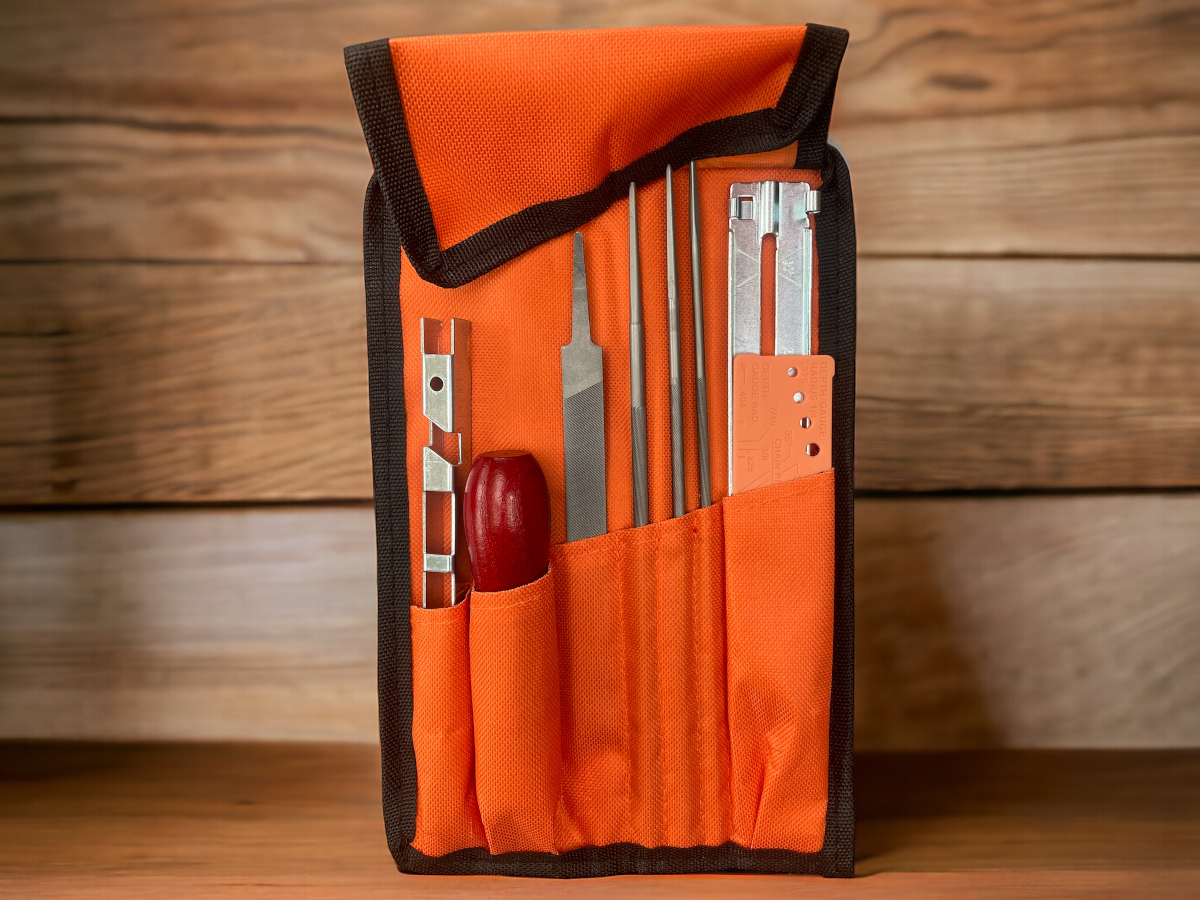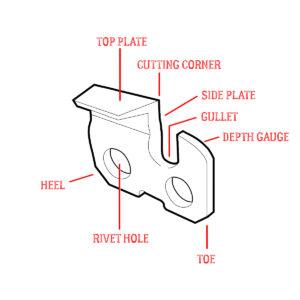
CHAINSAW CHAIN & SHARPENING GUIDE & TECHNIQUES
Arborists, foresters, gardeners and landscape professionals use chainsaws regularly to fell and manage the growth of trees. When it comes to maintaining chainsaws, having a reliable chain & sharpening guide is crucial. Powered by conventional engines and newer electric battery-powered systems, it is the chainsaw chain that is most important. The component should always be kept in prime condition to optimise cutting performance. Dull chains will simply cut wood less effectively. They typically take longer too. They are also more likely to snap and damage the chainsaw, both a risk to the user and to the longevity of the saw.
A chainsaw chain can ‘go’ dull from repeated use. It can also be affected after hitting dirt or having the cutting edge damaged by a ‘dirty’ tree, one that has stone fragments and metal pieces within the tree itself. A bent bar can often impact on the cutting performance when a side of the chain is more worn. Using a chain & sharpening guide ensures a productive tool with a sharpened edge can perform. It also reduces the exerted effort by the user.
There are two main methods for sharpening a chainsaw chain. By hand using a round chainsaw file or using an electric chainsaw grinder. It is always important to read chainsaw manuals and follow set-up instructions. This ensures that the technique and maintenance tool used is compatible with the chain to be ground. Grind your chain to the recommendations of the manufacturer with the guidance from a detailed chain & sharpening guide.
The right tools and good protective clothing?
Checking the condition of the chainsaw teeth, and ensuring chain oil is adequate is important before cutting wood. Giving the tool a check over for general maintenance and tensioning is important too. It’s important to wear appropriate protective clothing when operating and carrying out general maintenance of a chainsaw. When using a chainsaw, personal protective clothing includes chainsaw protective boots, trousers, gloves, helmet and visor, and hearing protection ear muffs. Protective chainsaw clothing is specially fabricated to restrict the chainsaw from operating if the fibres are torn from the garment within fractions of a second when it makes contact with the chain. Crucially, the special fabric does not offer protection against cut injuries. However, it significantly reduces the risk and injury caused. Always wear protective safety equipment and follow manufacturer guidance when using tools and equipment. This is an integral part of any chain & sharpening guide to ensure safety.
Preparation for saw sharpening

- Step 1: Make sure your chainsaw is turned off before you perform any maintenance.
- Step 2: Before sharpening, you need to know the type of chain and sharpening angle specifications of your chainsaw. This information can be found in your chainsaw owner’s manual or chain pack. The chain identification code is typically written on the drive link. A good chain & sharpening guide will highlight the importance of these specifications.
- Step 3: Put on your protective safety equipment and clothing, including gloves and eye wear. If you are sharpening the chain on the chainsaw bar, make sure it is tensioned properly first.
- Step 4: Remove and wipe away oil and grease residue on the chain to create a clean safe working surface. This also prevents the build-up of oil and grease on the file teeth and allows for a smoother file action, as recommended in any comprehensive chain & sharpening guide.
- Step 5: Inspect the chainsaw chain for damage and irregularities. Look out for proper installation of tie straps and drive links; cracked or broken cutters, cutter top plates or tie straps; bent, cracked or burned drive links; irregular worn chain; abrasive damage; wear patterns that may indicate a worn bar or sprocket; loose rivets. If the chain is broken, repair or replace it.
Saw sharpening – By hand with a round file
- Step 6: Select the correct file guide and file for your chainsaw chain.
- Step 7: Engage the chain brake. Lightly clamp the chainsaw bar in a saw vice. Release the chain brake to enable rotation of the chain by hand. Always wear gloves and motion the chain slowly to avoid injury.
- Step 8: When using a file guide, place this over the cutter with the round file in the gullet (between the cutter and the depth gauge). Make sure the file guide has two points of contact, one on the cutter top plate and the second on the depth gauge for accurate balance.
- Step 9: Hold the round file in the correct location so that 1/5″ (20%) of the round file diameter is positioned above the cutter’s top plate. Using a file guide holder is the easiest way to hold the round file in position. It assists with providing engraved angles to work with, as often illustrated in a chain & sharpening guide.
- Step 10: Locate the cutter with the most damage. Sharpen using controlled, steady strokes using the full file length to remove the damage. Count the number of file strokes to maintain consistency. Any damage removed will be visible when the cutter has a shiny, silver profile. File all cutters with the same number of strokes per cutter from the inside to the out so that the cutter lengths are equal. Complete all cutters on one side of the chain before turning your chain to switch sides. Remember to keep all cutter lengths consistent and equal, a principle often emphasised in a chain & sharpening guide.
- Step 11: Check and adjust the depth gauge where necessary. Sharpen your chain keeping it balanced with the correct file and angle as stated by the chainsaw manufacturer.
After sharpening
- Step 12: Clean off any debris and burrs.
- Step 13: Lubricate the chain thoroughly with chain oil.
- Step 14: Store the chain with lubricant ready for its next use.
This Chainsaw Chain & Sharpening Guide is intended to give information and advice only. It is the user’s responsibility to ensure that the necessary training and experience is achieved to use the tools safely.
